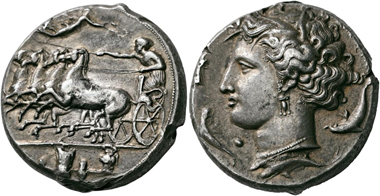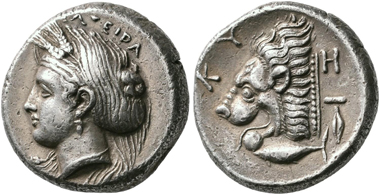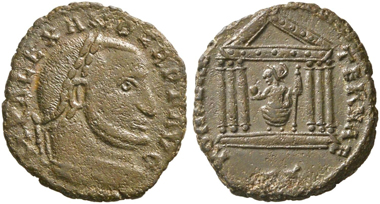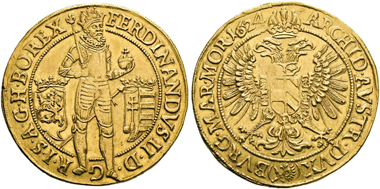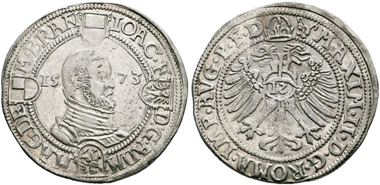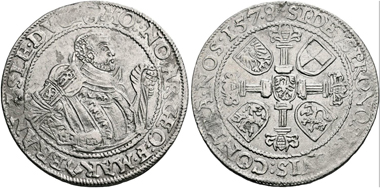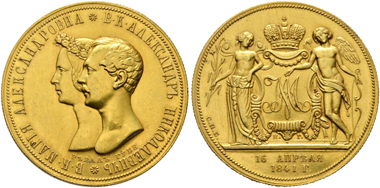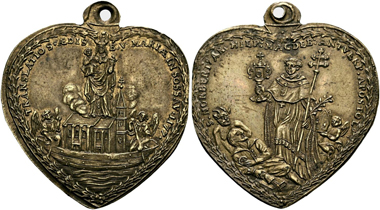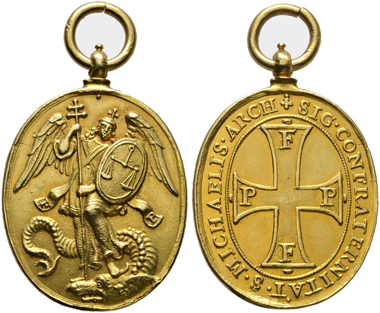10-06-2018 – 01-01-1970
Auction 166: Numismatic rarities
Numismatic rarities at Lanz
On June 11, 2018 the auction house Lanz from Munich will hold its 166th auction. It encompasses 326 lots, which include a large number of rarities of the finest grade reaching from antiquity to the 19th century.
It contains
- 3 lots Celtic coins
- 77 lots Greek coins
- 21 lots Roman Republican coins
- 92 lots Coins of the Roman Empire
- 7 lots Byzantine coins
- 21 lots Coins of the Holy Roman Empire featuring Germany, too
- 19 lots World coins and medals
- 86 lots Religion and pilgrimage token
No. 9. Syracuse (Sicily). Decadrachm, unsigned work by Euainetos, circa 400 BC. Rare. Extremely fine. Estimate: 30,000,- euro.
In the section of this ancient coins one finds many coins of perfect grade. This decadrachm from Syracuse, an unsigned work by Euainetos, made around 400 BC in the finest classical style, will surely attract the attention of many collectors.
No. 25. Amphipolis (Macedonia). Tetradrachm, 364-363. Very rare. Very fine. Estimate: 50,000,- euro.
Likely to be even more coveted is the tetradrachm of Amphipolis which depicts a head of Apollo on the obverse which almost appears feminine-like.
No. 51. Cyzicus (Mysia). Tetradachm, 390-340/1. High relief. Very fine. Estimate: 6,000,- euro.
Enthusiasts of hellenistic art will surely find great interest in a tetradrachm from Cyzicus. It was coined between 390 and 340/1 and has a particularly high relief.
Fractions deserve your attention as well. For example, who has heard of the Loggane mint? Its litra depicts the head of Heracles on the obverse and the head of a young river god on the reverse. Be it a pentonkion or a dionkion from Gela, be it a coin of Naxos or Zankle-Messana, all collectors of fractions are offered plenty of choices here.
No. 72. Bahram I. (Sasanids), 273-276. Gold dinar. Very rare. Extremely fine. Estimate: 12,000,- euro.
Collectors of Sasanid coins will be delighted at the large selection. Not only drachms, but gold dinars too are offered, for example those of Shapur I, Bahram I and II as well as Xusro II.
No. 98. Roman Republic. L. Staius Murcus. Denarius, 42-41 BC. Extremely rare. Slightly smoothed. Almost extremely fine. Estimate: 4,000,- euro.
21 lots in this auction originate from the time of the Roman Republic. The coins of the Roman Imperators are especially remarkable. They include not only an expressive portrait of the old Iulius Caesar, but also a denarius of perfect grade that joins the portraits of Marcus Antonius and Octavianus.
The rarest piece of this selection is probably the denarius of L. Staius Murcus, a lesser-known general of the Roman Civil Wars. Staius Murcus began his career as Caesar’s legate but switched to the sides of Caesar’s murderers after his death. This coin offered by Numismatik Lanz was issued by Staius Murcus during his time as naval prefect under Cassius. After the defeat of Caesar’s murderers he became an ally of Sextus Pompeius. It was the latter who then had Staius Murcus killed at the end of 40 or the beginning of 39 BC.
No. 148. Marcus Aurelius. 161-180. Sestertius, 169/70. Very rare. Extremely fine. Estimate: 3,000,- euro.
Connoisseurs will find approximately 100 lots from the time of the Roman Empire. Whether it be aureus, solidus, denarius, antoninianius or bronze coins – every collector will find something here.
No. 188. Alexander of Carthage. 308-310. Follis, Carthage. Very rare. Very fine. Estimate: 3,000,- euro.
These coins are estimated rather low. Especially the sestertii, dupondii, and asses, which are smoothed – a typical sign for originating from old collections, will find respective enthusiasts. The Julio-Claudian dynasty is represented in a large number of coins. What is more, a follis of Alexander of Carthage is auctioned only very rarely.
No. 201. Holy Roman Empire. Ferdinand II, 1619-1637. 10 ducats 1624, Prague. Very rare. Extremely fine. Estimate: 10,000,- euro.
The modern times section begins with a magnificent, extremely fine 10 ducats coin minted in Prague in 1624. This exceptional piece will be delivered in an antique gift case.
No. 204. Magdeburg / Germany. Joachim Frederick of Brandenburg, 1566-1598. 1/2 taler 1573 with the title of Maximilian II. Extremely rare. Almost extremely fine. Estimate: 15,000,- euro.
If you know the auction house Lanz, then you are aware that they follow an austro-centric approach. Lanz categorizes Germany as part of the Holy Roman Empire – which is historically correct, yet unusual in the field of numismatics. Thus, a very rare half taler coined in Magdeburg in 1573 can be found as part of the Holy Roman Empire.
No. 213. Krnov / Germany. George Frederick of Brandenburg, 1556 – 1603. 1/2 taler 1578, Krnov. Very rare. Partially rough surface, otherwise almost extremely fine. Estimate: 10,000,- euro.
One would be inclined to assign Krnov (germ.: Jägerndorf) which now is located in the Czech Republic, to the Habsburg dynasty. However, since 1523 a side branch of the Hohenzollerns had been governing the region. Their reign ended with George Frederick, whose very rare half taler is offered at Lanz. George Frederick lost Krnov due to his relentless support of the Winter King at the beginning of the Thirty Years’ War. The Emperor surrendered Krnov to Karl of Liechtenstein, whose descendants remained there until 1945.
No. 231. Russia. Nicholas I, 1825-1855. Medal-like golden ruble 1841, St. Petersburg. On the occasion of the wedding of the future Alexander II. and Maria of Hesse and by Rhine. Very rare. Almost FDC Estimate: 25,000,- euro.
In auction 166, Numismatik Lanz offers three rare Russian gold medals. One is a medal-like gold ruble from 1841 celebrating the wedding of the later Emperor Alexander II, as well as a gold medal of Alexander II. from 1858 featuring Saint Isaac’s Cathedral, which is still the largest cupola-domed basilica in the world (estimate: 20,000,- euro). Yet another gold medal in FDC depicting the portrait of Nicholas II, which was meant to be a prize awarded by the Alexandrov Institute, completes this small selection (estimate: 10,000,- euro).
No. 236. Uri, Schwyz and Unterwalden / Switzerland. 1/2 taler 1561, Altdorf. Extremely rare. Slightly double struck, otherwise extremely fine. Estimate: 50.000,- euro.
Only two other specimens remain of this extremely rare half taler of the joint coinage of the Cantons of Uri, Schwyz and Unterwalden. One can be found at the Swiss National Museum; another was sold at Leu Numismatik’s auction 82. A third one can now be obtained at Numismatik Lanz.
No. 277. Religion and pilgrimage. Sossau. Brass heart-shaped pendant celebrating the 500th churchly anniversary of Paul Seel. Very rare. Extremely fine. Estimate: 1,000 ,- euro.
One thematic focal point of this auction is an extensive selection of unusually well-preserved medals, tokens and pendants in the category of religion and pilgrimage. From Altötting to Waldsassen, these pieces from many religious centers display the variety of baroque beliefs. Who still knows that the pilgrimage chapel of Sossau, which is a part of Straubing today, was celebrated as a German Loreto in the 18th century? The conferral is portrayed on the medal: angels transport the Blessed Virgin’s house on a Danube bark.
No. 302. Religion and pilgrimage. Golden token of the St. Michael’s arch-brotherhood. From the collection of Rudolf Höfken of Hattingsheim. Extremely fine. Estimate: 5,000,- euro.
The arch-brotherhood of St. Michael, which was founded by Joseph Clemens of Bavaria in the church of Berg am Laim in 1693, was of great importance for Catholic daily life. As opposed to the Order of Saint Michael, which was open only to nobility, every one could become a member of this brotherhood. It is said to have had up to 100,000 members in its heyday. Every member once carried a token like this showing the initials FPFP, which stood for Fideliter (loyally), Pius (faithfully), Fortiter (bravely) and Persevanter (perseveringly).
Please remember! Only a customer attending the Numismatik Lanz Auction directly – sending a bid by letter or phone, over the internet or participating in person – is entitled to the preferential starting price of 60%! Please make sure to plan ahead: The auction sale catalog can be viewed online. You may as well request a printed copy for a nominal charge of 10 euros at Numismatik Lanz, Maximiliansplatz 10, D-80333 Munich, e-mail, phone: +49 / 89 / 29 90 70, fax: +49 / 89 / 22 07 62




